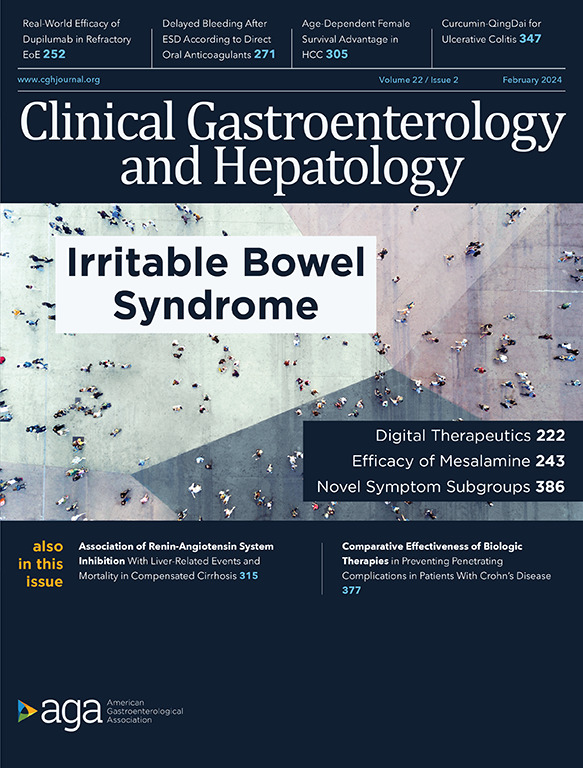Alcohol Rehabilitation Within 3 Months After Alcohol Hepatitis and Survival: A National Analysis
IF 11.6
1区 医学
Q1 GASTROENTEROLOGY & HEPATOLOGY
引用次数: 0
Abstract
Background & Aims
There is limited understanding of the benefits of alcohol rehabilitation after alcohol hepatitis (AH).
Methods
We conducted a 2012 to 2021 national longitudinal study involving adult inpatients diagnosed with AH in France. We assessed the primary outcome of liver transplantation or death within 1 year after AH, including in its complicated form (CAH) defined as ≥2 hepatic or extrahepatic complications within 4 weeks after AH. The primary exposure was in-hospital alcohol rehabilitation within 3 months following AH. Patients who died (6.5%; n = 5282) or were censored (12.5%; n = 10,180) ≤4 weeks after AH were excluded. We measured adjusted hazard ratios (aHRs) and adjusted odds ratios (aORs) within the full cohort and propensity-matched samples.
Results
Among 65,737 patients (median age, 52 years; interquartile range [IQR], 44–60 years; 76% male), 12% died or underwent liver transplantation. In-hospital alcohol rehabilitation was noted for 25% of patients (15.2% among patients with CAH) and was the primary discharge diagnosis for 13.3%. The 1-year transplant-free survival rates were 94% (95% confidence interval [CI], 94%–95%) for rehabilitated patients, compared with 85% (95% CI, 85%–86%) for those without (aHR, 0.62; 95% CI, 0.57–0.69; P < .001). Among patients with CAH, transplant-free survival was 78% (95% CI, 76%–81%) with rehabilitation vs 70% (95% CI, 69%–71%) without (aHR, 0.82; 95% CI, 0.68–0.98; P = .025). In propensity-matched samples, rehabilitation was linked to an aOR of 0.54 (95% CI, 0.49–0.55; P < .001) overall, and 0.73 (95% CI, 0.60–0.89; P = .002) among matched patients with CAH.
Conclusions
In-hospital alcohol rehabilitation within 3 months after AH and CAH improve transplant-free survival rate but remain underutilized.
酒精中毒后 3 个月内的酒精康复与存活率 - 一项全国性分析。
背景和目的人们对酒精性肝炎(AH)后进行酒精康复治疗的益处了解有限:我们开展了一项 2012-2021 年全国纵向研究,研究对象为法国确诊为酒精性肝炎的成年住院患者。我们评估了酒精性肝炎后一年内进行肝移植或死亡的主要结果,包括其复杂形式(CAH),即酒精性肝炎后 4 周内肝脏或肝外并发症≥ 2 例。主要暴露是在接受人工流产术后 3 个月内接受院内酒精康复治疗。酒精中毒后 4 周内死亡(6.5%,n=5,282)或剔除(12.5%,n=10,180)的患者被排除在外。我们测量了整个队列和倾向匹配样本的调整后危险比(aHR)和几率比(aOR):在 65737 名患者(中位年龄 52 岁;IQR 44-60 岁;76% 为男性)中,12% 的患者死亡或接受了肝移植。25%的患者(15.2%的CAH患者)在院内进行了酒精康复治疗,13.3%的患者的主要出院诊断是酒精中毒。康复患者的一年无移植存活率为94%(95% CI:94%至95%),而未康复患者的一年无移植存活率为85%(85%至86%)[aHR 0.62 (0.57 至 0.69) p < 0.001]。在CAH患者中,康复后的无移植生存率为78%(76%至81%),而未康复的为70%(69%至71%)[aHR 0.82 (0.68 至 0.98) p = 0.025]。在倾向匹配样本中,康复治疗与总的 aOR 值 0.54(0.49 至 0.55,p < 0.001)相关,与匹配的 CAH 患者的 aOR 值 0.73(0.60 至 0.89,p = 0.002)相关:结论:AH和CAH术后3个月内的院内酒精康复治疗可提高无移植生存率,但仍未得到充分利用:无外部资助。
本文章由计算机程序翻译,如有差异,请以英文原文为准。
求助全文
约1分钟内获得全文
求助全文
来源期刊
CiteScore
16.90
自引率
4.80%
发文量
903
审稿时长
22 days
期刊介绍:
Clinical Gastroenterology and Hepatology (CGH) is dedicated to offering readers a comprehensive exploration of themes in clinical gastroenterology and hepatology. Encompassing diagnostic, endoscopic, interventional, and therapeutic advances, the journal covers areas such as cancer, inflammatory diseases, functional gastrointestinal disorders, nutrition, absorption, and secretion.
As a peer-reviewed publication, CGH features original articles and scholarly reviews, ensuring immediate relevance to the practice of gastroenterology and hepatology. Beyond peer-reviewed content, the journal includes invited key reviews and articles on endoscopy/practice-based technology, health-care policy, and practice management. Multimedia elements, including images, video abstracts, and podcasts, enhance the reader's experience. CGH remains actively engaged with its audience through updates and commentary shared via platforms such as Facebook and Twitter.

 求助内容:
求助内容: 应助结果提醒方式:
应助结果提醒方式:


